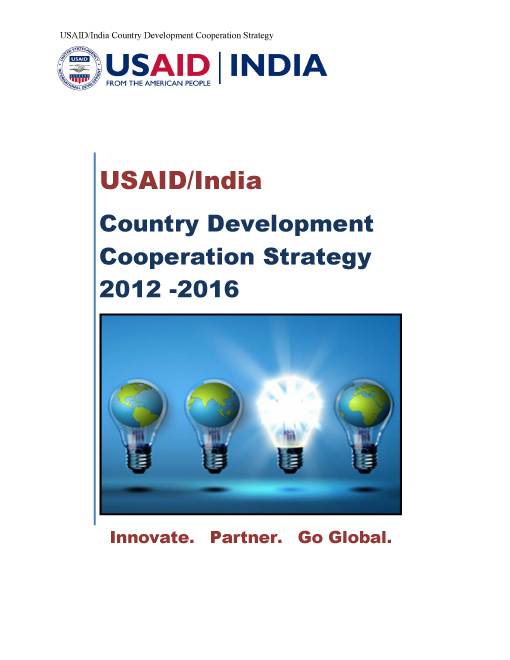Innovate. Partner. Go Global.
USAID/India Country Development Cooperation Strategy ![]() (pdf - 2 MB)
(pdf - 2 MB)
The U.S. Agency for International Development’s (USAID) five-year Country Development Cooperation Strategy (CDCS) acknowledges India’s growing economy, rising geopolitical status, and remaining development challenges, while simultaneously building on USAID’s comparative advantage and long relationship with the country of India. The CDCS reflects a total recasting of the USAID-India relationship from a traditional donor-recipient relationship to a peer-to-peer partnership for addressing Indian and global development challenges. Given India’s growing financial and human resources, USAID’s comparative advantage is not its dollars; it is as a convener, accelerator, and broker. USAID can leverage a range of resources – partnerships, skills, expertise, and technologies – to identify, test, and scale innovations that sustainably advance economic development in India; and that have strong potential for development impact in other countries.
Strategic Rationale
As a rising economy, India has enjoyed growth rates approaching eight percent over the last decade, and possesses a large and increasingly skilled labor force. However, India still faces a wide range of development challenges. It is home to the world’s largest concentration of poor people and ranks 134 of 187 countries in the 2011 Global Human Development Report. Moreover, with India’s population on course to reach two billion people in 2070, India is facing food, energy, and other natural resource constraints on a grand scale.
However, India is recognized as a place where the public and private sectors are generating innovative and effective solutions to these development challenges. India has a blend of increasing supplies of financial capital, expanding technological prowess, a dynamic private sector, a large number of non-profit organizations committed to grassroots efforts, and entrepreneurial talent across many income strata. These qualities open vast opportunities for public and private players at all levels to devise solutions that generate social benefits and commercially viable products, technologies, and services uniquely suited to those with limited means.
Over the next five years, USAID will fully transition to a new strategic approach, a shift that is already underway. While continuing to provide targeted assistance to strengthen the systems needed to achieve sustainable results in health and climate change, USAID will reduce its emphasis on traditional approaches to funding grants and contracts, particularly the provision of technical assistance through large, multi-year mechanisms. It will increasingly adopt methods focused on innovation and partnerships: more directly engaging local partners; leveraging cofinancing instead of USAID fully funding agreements on its own; and developing platforms and alliances to generate development outcomes that encompass multiple organizations. This means that USAID staff will spend less time managing contracts and grants, and will instead spend more time building networks with local partners, conducting outreach, and connecting with Indian innovators to understand trends with the potential for significant Indian and global impact.
The Mission uses an overarching goal and beneath it two sub-goals to represent a reduction in emphasis on traditional approaches of funding grants and contracts. USAID/India’s overarching goal for the strategy period is USAID-India partnership transformed to increasingly contribute to global efforts to solve worldwide development challenges. The goal will be achieved through the following two sub-goals and four Development Objectives (DOs):
Sub-Goal 1: Indian systems strengthened in priority sectors
-
DO 1: Increase the capacity of India’s health system to improve the health of vulnerable populations in India.
-
DO 2: Accelerate India’s transition to a low emissions economy.
Sub-Goal 2: Indian innovations accelerate development outcomes in India and globally
-
DO 3: Development innovations impact people's lives at the base of the pyramid (BOP) in a range of sectors in India.
-
DO 4: Innovations proven in India increasingly adopted in other countries
Sub-goal 2 will receive an increasing share of resources over the life of the strategy while subgoal 1 will slowly be phased out over the course of the strategy. It must be noted, though, that both sub-goal results are aimed at supporting development outcomes, including those related to Agency Presidential Initiatives.









Comment
Make a general inquiry or suggest an improvement.